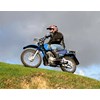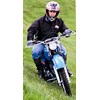Yamaha AG200







|

|

|
Yamaha’s AG200 remains an intelligent choice for a farm bike

|
|
Yamaha AG200
|
After almost four years since I first tested Yamaha’s AG200 for Farm Trader, I’m pleased to report that nothing has changed. Ever since the first AG100 rolled off the assembly line in December 1972, Yamaha has been renowned for producing rock-solid dedicated farm bikes for the NZ market. And farmers are still buying them in droves for one purpose - farming.
Yamaha produces two models of the AG200, an electric start version and a budget oriented kick-start model. The only other differences between the two models are the front wheel size, the electric voltage (6 volt for the kick-start model) and price.
The AG200 kick-start model comes with a smaller 19"diameter front wheel, as opposed to the AG200E electric start models 21" hoop. I mainly rode over incredibly rough, steep terrain, where the bigger front wheeled AG200E gives an overall better feel but, more importantly, greater rider control, meaning it is a little safer to ride.
Speeding through the paddock was an easy affair, thanks to the long travel front and monoshock rear suspension. All the bumps were easily soaked up which made the riding experience a whole level better than what I received from the smaller range of farm bikes I have tested, including Yamaha’s own AG100. Sure, the smaller bikes are cheaper, however Yamaha offer the kick-start only version to appeal to farmers who have a limited budget or who may not ride it very often.
The air cooled 196cc four-stoke engine is the same old tried and trusted powerplant from way back. It has more than enough power to grunt straight up near impossible hills in first gear. The five-speed gearbox has neutral right at the bottom, something I quickly became used to - I’d come up to a gate and just kept banging it down the gears until I saw the green neutral light on the simple but functional speedo unit. Unlike some of the taller geared trail bikes I’ve ridden recently, the AG200 seems to be made for the farm and the speed range of each gear was perfect around the Waingaro hill country farm I was lucky enough to use. First and second gear are very low, with first designed to be slow enough to ride down a race behind the herd without having to slip the clutch, or come to a periodic stop.
The braking power was typical of a brand new bike fitted with drum brakes. They didn’t have a lot of power nor feel because drum brakes takes longer to bed in from new than more modern disc brakes. The theory was backed up in practice as the brakes got marginally better during my test on the Waikato Yamaha supplied AG200. The only place where I really needed the brakes was while riding down those super-steep downhill sections - mountain goat stuff, which just goes to show how versatile and agile the AG200 really is.
Perhaps the single most important thing for a farmer, after reliability, is seat comfort. Yamaha came to the party years ago and developed an extra wide seat with deep sides to cater for people who tend to spend a lot of time in the saddle. At no point during my ride did I even think about a sore behind – a sure sign that all was well with the seating arrangements.
After a good ride there were a couple of occasions where an electric start would have helped. The most serious was when tackling gradients so steep that I stalled the bike, leaving me in a precarious balance situation on the side of a hill as I held the front brake on while positioning the kick-start lever with my left hand, without tipping over or running backwards. The other time was when the bike stalled while going through a gate, so the electric start version does make a good bike even better for farmers who would use it more.
Features I did like are the strong and sturdy carriers, the engine protection bar and the fully enclosed chain guard to make the chain last much longer. On the safety angle, almost every week I still read a newspaper report about an ATV injury because of roll-over somewhere around the country. Using a two wheeler continues to be a valid and I think considerably safer option to get around the farm. Olay, we all know you can fall off a two wheeler too, but dedicated farm bikes generally weigh no more than 125kg dry, and don’t crush you like a 250kg plus ATV on the second bounce, as it careens down the hill! Think about it…
The $4895 (incl GST) AG200 must be one of the most reliable, sought after and versatile farm bikes built for dedicated farmers. The AG200E rolls out a grand more at $5895 and both are cheaper than when I did my 2003 test.
By Terry Stevenson
Engine and transmission
Displacement:
196.00 cubic cm (11.96 cubic inches)
Engine type: Single cylinder, two-stroke
Compression:
9.5:1
Bore x stroke:
67.0 x 55.7 mm (2.6 x 2.2 inches)
Fuel control: SOHC
Ignition: CDI
Starter: Electric & kick
Lubrication system: Wet sump
Cooling system: Air
Gearbox: Six-speed
Transmission type
final drive: Chain
Keep up to date in the industry by signing up to Farm Trader's free newsletter or liking us on Facebook



.jpg)




.jpg)
.jpg)
.jpg)

